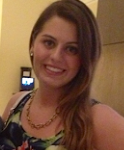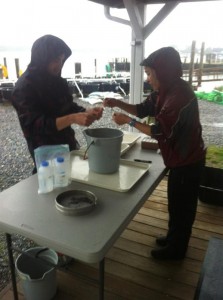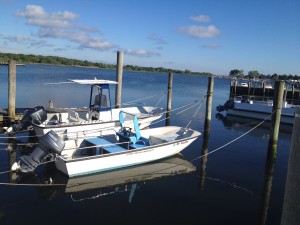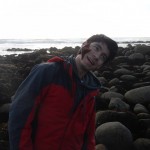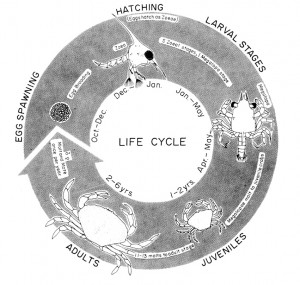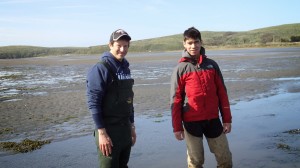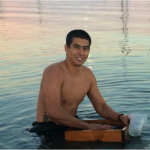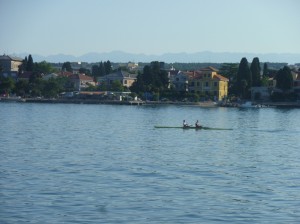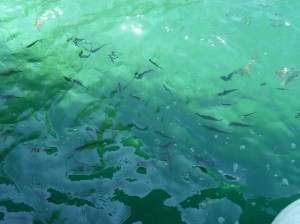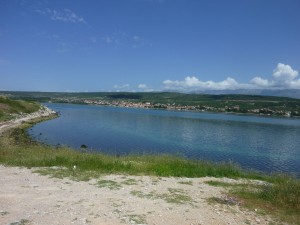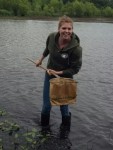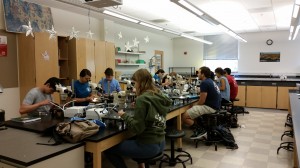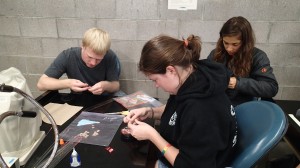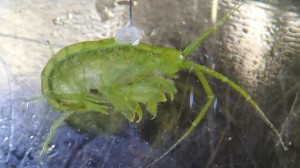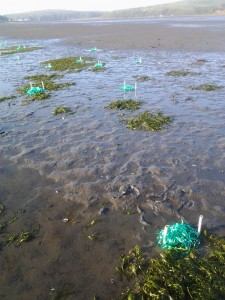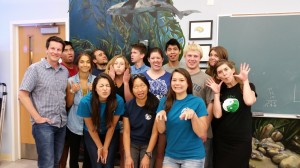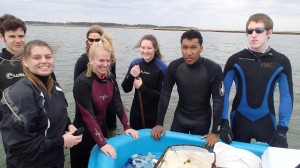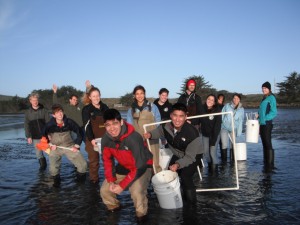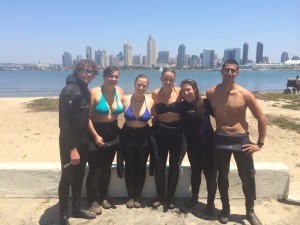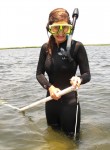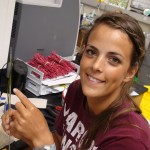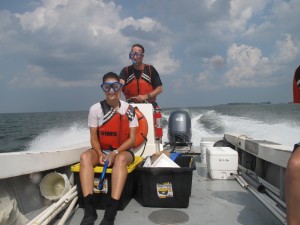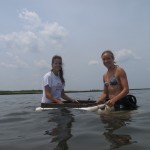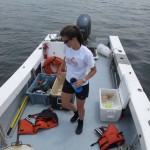A little closer to home – ZEN in Long Island Sound
by Ally Farnan (College of William and Mary undergraduate, ZENtern)
Even though Long Island is not a conventionally exotic location for a girl from New Jersey to spend the summer, it is starting out to be quite an adventure.
I arrived on site less than two weeks ago and I already feel like a part of the family here in the Peterson lab. I have spent the past week prepping for the ZEN experiments in the lab. Though a crucial step in the process of running experiments and conducting research, spending a week making aluminum packets, labeling, and weighing tins is not exactly thrilling. It is, however, a necessary part of the process, and is giving me some great practice for the eventual post-processing, sorting, and identification of field samples yet to come. I’m still figuring out where everything in the lab is located, but am getting some excellent help from the other undergraduate volunteers working the lab.
Luckily, I get to start running the actual experiments on Monday, which will also be the first time that I get to see the seagrass bed that we will be working in. Since I have been so busy in the lab, I haven’t had the opportunity to get into my wetsuit and see the site. The area that we are located in is beautiful, so I expect that the study site will also be wonderful!
I’m living a short drive from the lab with two graduate students, which gives me an interesting perspective on how different science research is from the typical 9-5 business job. My housemates, Rebecca and Sam, are excellent hosts and it’s so much fun to hear about the different kinds of research that they do. It should be really exciting to delve further into the experimental stages of ZEN so I can gain some hands-on experience myself.
The lab here is nearby, just off the water. The weather has been great most days, so I’ve been able to explore the area by jogging around town and by the beach. I hope to see some more of the sights around where I am staying. All of my new friends in the lab have given me some great ideas for how to spend my free time during the upcoming weekends - I can’t wait to discover what makes Long Island so special.
It is surprisingly chilly here, so I haven’t been brave enough to go swimming just yet since my toes freeze every time I stick them in the water. But, the sun is constantly shining, making for some beautiful drives around town with my windows down. I can’t wait to continue my adventures here by getting some fieldwork experience. I’ve already packed up my wetsuit so I don’t freeze in the cold water!
I’m so lucky to have a bunch of help in the lab, not only to settle me into a new space and help me to learn more about seagrass ecosystems, but also to advise me on some cold weather gear for our fieldwork in the next few weeks! I’m sure my future blog posts will be filled with some exciting fieldwork stories and hopefully I’ll still have a little free time to explore the area and tell you more about those experiences as well!
A closer look at an eelgrass inhabitant – the Dungeness crab
by Jason Toy (Undergraduate student in the UCD ZEN class)
Several weeks ago, I was out at Bodega Bay with my classmates from the UCD ZEN course collecting field data for our research projects. As I stood out there in the water in my borrowed waders, I observed quite a few different species of invertebrates as they made their way through the bed of eelgrass. Most were quite familiar to me at that point, but there were a few species, including the Dungeness crab, Cancer magister, that I had not thought of as typical eelgrass inhabitants. I decided to do a little research on the life history of these crustaceans in order to better understand the importance of estuarine seagrass beds to this – and potentially other – important crustacean species.
I was surprised to learn that these crabs move around quite a bit during their life histories. Adults mate in nearshore coastal locations in the Pacific Northwest throughout the spring (Pauley et al., 1989), a process in which the male embraces the female for up to 7 days before she molts, after which the actual transfer of sperm occurs. She stores this sperm for about a month until she extrudes her eggs and, in the process of doing so, they are fertilized (Tasto et al., 1893). But her care doesn’t end there. She protects her eggs by storing them on her abdomen for several months until winter (typically December – January). Then one day, these 1-2 million eggs hatch and the baby crabs leave their mother and enter a 105-125 day planktonic larval period. During this time the young Dungeness crab goes through many developmental changes, moving through 5 zoeal and 1 megalopal stages. After reaching the megalopa stage, the young crabs settle out onto the bottoms of bays and estuaries, where they molt into their first juvenile crab stage and begin to actually resemble real crabs.

During field sampling, Jason and classmates found a few juvenile Dungeness crabs hiding amid the eelgrass in Bodega Bay, California
This is where seagrass comes in! Coastal estuaries (like Bodega Harbor) play a critical role for juvenile Dungeness crabs as a nursery. Large numbers of juvenile crabs benefit from the protection and substrate provided by beds of eelgrass (Zostera marina). They cling to and hide within the grass, consuming other small organisms within the habitat (amphipods, isopods, polychaetes, essentially whatever they can catch!) (Pauley et al., 1989). After several molts, subadults and adult Dungeness crabs begin to leave the eelgrass beds and move offshore, but a few do remain in inland coastal waters, hiding among the eelgrass blades.
The role of seagrass beds in the life history of Dungeness crabs is an important interaction to talk about because it is an example of an economic benefit (known as an ecosystem service) provided by seagrass beds. Seagrasses are critical species in coastal environments around the globe, as they form habitat structure and promote a large diversity of organisms. However, like the coral reefs, they are currently in decline due to the effects of human activities. The connection of an economically important species such as Cancer magister to these seagrass ecosystems, however, can help bring attention to this issue, and provide an incentive for the preservation and restoration of this habitat. Help spread the word!
For more information, check out these references:
Pauley, G. B., Armstrong, D. A., Citter, R. V., & Thomas, G. L. (1989). Species Profiles: Life Histories and Environmental Requirements of Coastal Fishes and Invertebrates (Pacific Southwest): Dungeness Crab. U.S. Fish and Wildlife Services Biological Report 82(11.121): 7-8.
Tasto, R. N., & Wild, P. W. (1983) Life History, Environment, and Mariculture Studies of the Dungeness Crab, Cancer Magister, With Emphasis on The Central California Fishery Resource. California Department of Fish and Game Fish Bulletin 172, 319-320. Retrieved June 11, 2014, from http://content.cdlib.org/view?docId=kt1k4001gs&&doc.view=entire_text
Jason is an aspiring marine ecologist with a passion for all things science. He is a rising senior at UC Davis studying evolution and ecology. His dream job is to be a research SCUBA diver. This summer he will be working in Dr. Jay Stachowicz’s marine ecology lab at UC Davis’ Bodega Marine Laboratory.
Loving science for the challenge
by Christopher Bayne (San Diego State University undergraduate, ZENtern)
Field days have to be one of my favorite parts of science for two main reasons. The first reason is fairly obvious – we get to go out to the field site, which means getting some exercise, being in the sun, and working in the natural environment. You can’t beat that! The second reason is less intuitive. I really enjoy the challenges of fieldwork and problem solving. No matter how well protocols are planned and how many times you go over them, it seems that the smallest thing can turn into the biggest pain. Even though these problems can be time consuming and counterproductive, they keep you on your toes.
Along those lines, the ZEN predation intensity experiment comes to mind. The first time we deployed the experiment, which tested different materials as potential standardized prey to be used in experiments conducted by all of the ZEN partners, we used braided line threaded through different bait types. We separated each bait into separate bags for “quick and easy” deployment in the field. However, when we reached our field site we soon discovered that, when braided line goes into a bag, the mixture of moving around, getting wet, and Murphy’s law results in a knot so bad that you can barely distinguish one line from another. It just so happens that this occurred to six of our eight different bait types. What do we do?
We approached the problem like you do with so many other unexpected field issues. You accept it and just jump in headfirst. You approach the knot and honestly, there is no apparent advantage of coming at it at any certain way. You just begin trying to separate each line one at a time. You try different things: weaving the bait end through, loosening the most knotted sections, pulling the line through slowly. You swear you’ve undone hundreds of knots yet the ball of tangled string never looks as if any progress was made. Finally, you notice one looks as if it is almost loose. You put all your effort into that and get it out with this silent victory to yourself. Eventually they are all loose and you re-wrap them in a way that they will not get tangled up again. You think about what you could or should have done to avoid this mess. You finish up what needs to be done, knowing you are ready for whatever comes next.
In the end, the problem of the knotted line may be small but it is symbolic of the problems researchers face all the time. Little complications creep out of nowhere, completely unexpected. You try a million different solutions and begin to loose faith when nothing seems to work. If you have enough patience, the knot will eventually loosen and you will be victorious, swearing that you will never make that mistake again. This is why I have chosen to do science. It is challenging in so many ways. Learning the correct terminology, setting up experiments, finding solutions to unexpected problems – these are just some of the reasons why science is challenging and yet very rewarding.
Working on a project as large as ZEN adds an additional level of complexity in both coordinating large teams of people distributed all over the globe. This summer I will be travelling to Japan to work with the ZEN partners in both Akkeshi and Hiroshima. It is an amazing opportunity that not many undergraduates get to be a part of. I am looking forward to all of the challenges I will be facing this summer. I’m sure there will be more than a few but, if I’ve learned my lesson, tangled fishing lines will not be one of them!
Chris is a rising senior at San Diego State University pursuing his bachelor’s in biology and Japanese. Before starting the ZEN program Chris worked with Dr. Violet Compton Renick on her dissertation research examining the interactive effects of parasites and pesticides on killifish behavior. During the SDSU ZEN course Chris led a feeding experiment where he measured the grazing rates of several different types of San Diego mesograzer. This summer Chris will be traveling as part of his ZENternship to Japan to assist Drs. Massa Nakaoka and Massakazu Hori.
The Adventure Begins
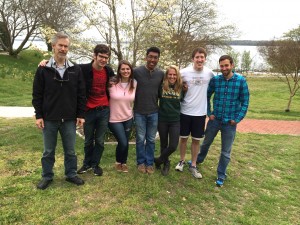
Dave Godschalk (second from the right) poses with Dr. Duffy (left) and the College of William & Mary ZEN class
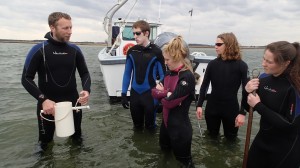
Dave (second from left) and ZEN classmates survey seagrass in the Chesapeake Bay before beginning their ZENternships
by David Godschalk (College of William & Mary undegraduate, ZENtern)
On my very first day of the ZEN Seagrass Ecology course at the College of William and Mary, I learned perhaps the most important lesson of the class, if not my scientific career. Our professor, Dr. Emmett Duffy, stood in front of our class and said these striking words:
“Things will not work out. You will mess up. Experiments will go wrong… Science is like that. The key, as an ecologist or any scientist for that matter, is to be able to adapt to those situations – to be creative and turn failures into successes. If you can do that, you will be successful not only as a scientist, but also as a person.”
As a geology major in an ecology class, this struck a chord with me. While I can go on and on about the structural and material properties that govern the Earth, different types of sandstones, and all those things near and dear to geologist’s hearts, I was out of my element in this course and I knew it. A fish out of water, one might say!
Those words on the first day are what saved me and I am so glad they did. Since then I have absolutely fallen in love with seagrass – the environment and the dynamics which govern the system. Even that particular seagrass-mud smell has grown on me. I will be writing entries for the ZEN Blog throughout the summer and one of my goals is to share with you my fascination with this unique environment. I hope to inspire you to feel the same way I do about this precious habitat and unprecedented project.
The Zostera Experimental Network (ZEN) is a collaborative, global study to examine what affects seagrass, and what role in turn seagrass play in coastal environments. What makes this project so unique is: (1) standardized experiments are performed worldwide, when often experiments in science can only be performed locally or regionally, and (2) undergraduate students (like me!) are sent to these global sites to practice and hone skills learned in class and contribute to the overall scientific study.
This summer I will be contributing to the ZEN research efforts in Zadar, Croatia, located across from Italy on the Adriatic Sea. It is a beautiful place and I am unbelievably excited to get things underway here. I will update you soon on how the experiments are going!
Dave is a graduating senior at the College of William & Mary and will be working with Dr. Claudia Kruschel in Croatia. His major is in geology with a marine science minor. Prior to studying seagrass ecology, Dave worked for Dr. Mark Patterson at the Virginia Institute of Marine Science on autonomous underwater vehicles (AUV) and completed an honors geology thesis. His favorite class at WM was structural geology – and rock climbing. When not snorkeling in the seagrass beds or surveying rocks he can be found running marathons.
A test worth taking
by Ellie Marin (UC Davis undergraduate, ZENtern)
Exams are inherently nerve-wracking. First there’s the main concern – did I study enough? Did I study the right material? And then there are other details – I have nightmares about running out of ink in my pen, accidentally missing questions on the back side of an exam
page, or even forgetting to write my name on the top of the exam paper. But, one thing I’d never feared was being stalled by accidently super gluing my hand to the exam paper itself. If there’s one thing I’ve learned from the Seagrass Ecosystem Ecology course taught by Drs. Pamela Reynolds and Jay Stachowicz that I’m taking at UC Davis, it’s to be prepared for the unexpected.
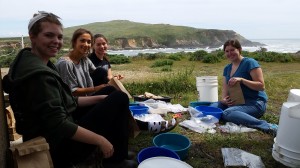
Ellie (left) and classmates conduct research at UC Davis’ Bodega Marine Laboratory for the ZEN undergraduate course in Seagrass Ecosystem Ecology
This hands-on field methods course was designed to educate the undergraduate students participating in the ZEN research (the “ZENterns”) on the methodology, theory, history, and purpose behind seagrass ecology and the Zostera Experimental Network. Our class featured a weekend trip to Bodega Bay, California to conduct field research, student presentations of papers from the primary literature, lectures, and group research activities. Today’s lab practical exam was intended to assess how much we learned from all of the different aspects of the course. In preparation for the exam, I read through my notes. It is a fairly hands-on class, so I wasn’t exactly sure how to study. Chatting with my 11 classmates revealed that we were all in the same boat.

UCD ZEN students perform the class practical exam, which involved answering questions on the course subject matter as well as demonstrating skills developed during the course.
Similar to other laboratory courses, our class practical featured a written portion as well as directed questions from a series of different stations setup around the laboratory. After a timed 30 minutes to complete the 5 pages of short answer questions, I started on the first lab station and the clock ticked down for us to rotate every 5 minutes. Some stations had microscopes with animals under them for us to identify and others materials for us to perform targeted lab skills. I glanced upon the familiar mesograzers under the scope, stumbled through some exotic amphipod identification, measured eelgrass shoots, and even wrote a haiku about epiphytes. The 5 minute periods per station rushed and rushed. I scribbled until the last second. And then I got to one station that fortunately, didn’t involve writing. Yes! Something I’ve done before! “Tether an isopod. Next, tether an amphipod.” We’d done this during our field trip at Bodega Bay to assess predation rates on mesograzers in the field. I got out the glue, set the line, caught the mesograzer. I was all set. No tricks. No doubts. I just had to tether the little guys. But this time it was different.
When we tethered the animals on the field trip, our instructors did not time us. This time I was racing against the clock. I quickly trimmed 20 cm of fishing line for the tether and began tying the proper knots to secure it. It wasn’t this difficult before! This line seems different! The sweat on my hands is not helping! After finally succeeding in tying an appropriate knot, I trimmed the line down and began looking for my first bug. I spotted one and bypass the forceps to plunge my hand into their housing container. I gently grab an isopod and place him on a paper towel to dry off. He’s sedentary. Good news. I grab the glue and squeeze a blob on the knot in my line. The next part is tricky. I have to glue his line – his crustacean leash – right onto his back. Success! After getting it to stick, I put the little guy into a water cup and watch him swim around with his little line in tow.
I’m half done now! I next set my sights on the amphipod. In the heat of the exam, I forget the order of the tethering process and plunge my hand into the container to grab the only amphipod I see. It’s a lively gammarid who undulates all over the paper towel, nearly off the table. This isn’t right! I put him back in the water. Focus! I grab the line and begin to cut to 20 cm again. The knot tying frenzy begins. Just go slow. I make a proper knot and grab the glue. It’s not coming out! I squeeze the glue harder than usual until a thick blob encases my knot… it’ll do. I grab my lively amphipod and he begins twisting and spinning – he’s expected me this time. I use a dropper to drip water on him as he lays on the paper towel. This appears to have a calming effect, and he ceases his tantrum. Now the tricky part. The isopod was big, but this guy is small, just under 1 cm in length. I have to get the glue right on the middle of his back or I risk injuring him. I go for it and miss, somehow getting glue all over my fingers. My fingers start to stick together. I unstick them and attempt to refocus in order to finish out this station – I know I’m almost out of time.
I rearrange my station for better focus, and this involves moving my exam out of the way. Big mistake. I have glued my hand to my exam. I rip the paper off, revealing a thumb and palm covered in ripped, sticky white paper. The timer goes off and I put my amphipod that wouldn’t get tethered back for the next student. “Next Station.” The test continues with new, equally challenging tasks and I proceed, with the paper still glued to my hand
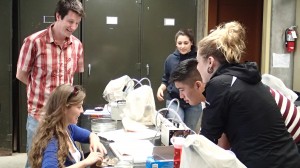
Drs. Pamela Reynolds and Jay Stachowicz (left) demonstrate amphipod tethering during the class field trip to the Bodega Marine Lab
The exam was hard. Not because I was underprepared – there are some things in life we can never prepare for. It was not unfair – I had either seen, performed, or learned everything on the exam. It’s not that there wasn’t enough time – everything in life has a time limit. The exam was hard because I have never had so much expected of me in a college class. Our instructors believe that we can do far more than simply answer A, B or C, or regurgitate a paragraph that we memorized from our notes. Our instructors dare us to reveal what we can actually contribute to science. They challenge us to be creative, resourceful, and clever. The point was to experience the exam, not just complete it. Success in research can be measured in how well we perform under stress. Things may not go as planned, but at the root of ecology is evolution, and we must all continue to adapt. This involves accepting our failures, building on our strengths, and focusing on how to move forward.
Some amphipods are meant to be free. Some tests are meant to be stressful. And some hands are meant to be glued.
Ellie is a rising senior at UC Davis pursuing her bachelor’s in biology. Her favorite aspect of the ZEN course was the exposure to field research, and her favorite experiment involved tethering amphipods to test for predation in the Bodega Bay seagrass beds. Her dream job is to be a science communicator and educator. She will be traveling to Ireland and Oregon to assist with ZEN research this summer with Drs. Nessa O’Connor and Fiona Tomas Nash, respectively.
Photos contributed by Aaron Goodman, Pamela Reynolds and Jay Stachowicz.
Surrounded by Science
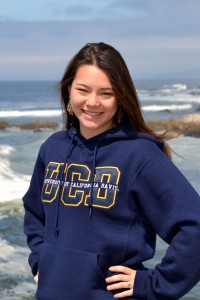 by Kendra Chan (UC Davis ZEN course undergraduate student)
by Kendra Chan (UC Davis ZEN course undergraduate student)
Over the past school year, I have finally found my people and my calling. I’ve been lucky enough to participate in the UC Davis ZEN course this spring quarter. Unlike your typical research university lecture hall of 300+ students, this class was limited to only 12 undergraduates. But it wasn’t the 6:1 student to faculty ratio that made this class special – rather, it was the people themselves.
As an underclassman, I was herded around the general biology pre-requisite path with the several hundred other students in the college. I found the intro biology series fascinating, but to my dismay, the majority of my peers expressed boredom even in the lab sections. However, this ZEN class was entirely different—it has been one of the few times I’ve been completely surrounded by people that are just as interested in marine ecology as I am, if not more (which I didn’t know was possible). Instead of being held back by classmates that lacked knowledge and interest about the subject at hand (e.g., marine communities), I was motivated and inspired by the passion and expertise demonstrated by the eleven other students and two instructors. Because of this, we were able to progress quickly through lecture topics and have intellectually stimulating discussions.
During the first class period, I knew I had found the right class because we had a lengthy and heated debate about how exactly to deploy the ASUs (Artificial Seagrass Units, or glorified green plastic ribbon) we had just built in order to get the most interesting data. This time, we the students were in control or our own experiment, and we had a plethora of scientifically interesting questions to ask. We weighed the pros and cons of each scenario, and after much discussion settled upon an experimental design.
Needless to say, the past 10 weeks have been a great learning experience for me. Not only did I become well versed in eelgrass ecosystems, but I also learned more about how to be a scientist through lectures, discussion, and my favorite, hands-on field work.
Although I won’t be exclusively working for ZEN this summer, I will still be immersed in eelgrass research. I’m excited to once again be surrounded by marine ecologists in Bodega Bay, and know I will continue to be inspired by both the scientists and the sea.
Kendra Chan is a rising senior at UC Davis. Her favorite experiment in the ZEN class was an assay of predation intensity in Bodega harbor. Her dream is to save the world with science – combining science and education with conservation and sustainability to better understand and utilize natural ecosystems.
Photos contributed by Kendra and Matt Whalen.
The ZEN of Active Learning
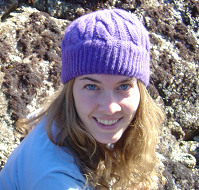 by Pamela Reynolds (ZEN postdoc and coordinator)
by Pamela Reynolds (ZEN postdoc and coordinator)
A novel component of ZEN2, in spring 2014 we launched a coordinated upper division undergraduate Seagrass Ecosystem Ecology course at each of the three core ZEN sites. Dr. Emmett Duffy and graduate student Jon Lefcheck instructed a group of 8 students at the College of William and Mary, Dr. Kevin Hovel and graduate student Erin Voigt taught 6 students at San Diego State University, and Drs. Jay Stachowicz and Pamela Reynolds co-taught another 12 students at the University of California, Davis. The course focused on ecological theory and hands on training in marine ecology field methods. We incorporated lectures and readings of the primary literature with field trips and student-led surveys and experiments.
Each course topic and experiment in the course corresponded to a main theme and goal of ZEN – from top-down/bottom-up ecology and biodiversity ecosystem functioning to experimental design and habitat restoration. In an immersion instruction style, students performed research typical in marine ecology, working both indoors and outdoors, with living organisms, under a wide variety of conditions. The students gave presentations both within their own class and, via teleconferencing, to the other ZEN classes. The course gave students a rigorous background in not only the “why” behind the science and a sense of the history of the field, but also the “how” of doing the science itself. With such small class sizes we were fortunate to be able to engage the students in this active learning style and to really connect with and get to know them. Success in the class was assessed by the students’ ability not to simply memorize facts, but to apply the core concepts of the course to design novel approaches and problem solve both individually and as a team. We hope that additional ZEN partners will engage with similar networked courses in the future and further strengthen the connections among our diverse partnership.
A subset of the students in the ZEN classes are participating in our ‘ZENternship’ program -a hands on training experience following the prior ZEN graduate student exchange program of 2012 and modeled after the NSF Research Experience for Undergraduates program. The ZENternship for 2014 involves student travel to different partner sites this summer to assist with ongoing ZEN research.
We were thrilled to have a great group of students participate in this first ZEN class and can’t wait to hear about their summer research experiences – both at home and abroad. And, we are all more than a little bit jealous that we didn’t have such an integrative class to take when we were undergraduates!
Check back here to read more about the ZENterns and their experiences conducting research at home and abroad this summer.
I’m a GRAZER baby…
by Pamela Reynolds (ZEN Coordinator)
As a small token of our appreciation for the hard work of all of the ZEN partners (past, present and future!), we present:
“GRAZER”. Turn up the volume and enjoy!
This film is, as everything in ZEN, a collaborative production and we very much appreciate the contributions of all of the ZEN participants. Lyrics were written by Paul Richardson, editing by undergraduate Conor MacDonnell, and lyrics by undergraduate Nick Penthorne. The film features cameos by Emmett Duffy and others in the Marine Biodiversity Lab at VIMS, as well as chorus refrains from many of the ZEN sites (watch the film all the way to the end so you don’t miss this!). The film premiered along with a select few other films on the big screen at the Beneath the Waves Film Festival at the Benthic Ecology Meeting last week in Savannah, GA. Enjoy!
Memorable moments in Virginia
by Katelyn Jenkins (College of William and Mary undergraduate student)
Many of the jobs I’ve tackled this summer have surprised me. I would not have guessed that I would become a PVC cutter, plaster block-maker, wire bender, mesh cutter, or sewer. However, I have learned that it takes a lot of skills, laughter, and water (often with a dash of Gatorade!) to prepare for such large-scale experiments in marine ecology. Through spending days of cutting many pieces of PVC and the messy job of making plaster blocks, I have enjoyed this job because of the new friends I have made in the MBL lab. From having numerous nicknames to help distinguish myself from the lab’s REU (also a Caitlin), to dancing on poles marking experimental cages in the field, this summer has been a great one to remember.
When I am not counting PVC or cutting wire, I have taken over the job of transferring seagrass samples from various ZEN partner sites to reinforced vials to grind down for nutrient (carbon and nitrogen) analysis. To do so, I have to go to William and Mary’s main campus to use a machine that will grind the samples (affectionately known as “Shakira” by its owner, Dr. Kerscher, who graciously allows us to use his lab space). The first few times I went to the main campus to grind the samples, the machine was placed in a lab. However, all of the large samples from partner sites makes for a very tired and warm ‘Shakira’. To resolve this, I planned to take breaks between sample grinding during my next visit. But, when I arrived on campus weeks later in almost 100° F weather in my shorts and t-shirt, I had no idea the machine was being moved to a cold room of 34° F! Though the initial “air conditioning” felt much needed, I quickly found myself freezing (literally) while trying to grind my samples. With multiple “defrost-Katelyn” steps inserted into the protocol (which involved running outside into the muggy Virginia heat until my fingers had thawed), I was able to successfully grind all of the samples. I can now say that I always come prepared with full gear to face the cold room. You can easily spot me walking across campus as I am the only one with a big jacket and pants in the middle of summer!
Aside from the strange climactic working conditions, I spend a lot of time in the field – one of my favorite parts! I have learned to master “Snorkeleese”, the language when talking with a snorkel in your mouth and your face down in the seagrass bed. “Ooo uoooo eeeddd elpppp?” translates easily to “Do you need help?” and “ablee eye eeese” almost always means “cable tie please”. All joking aside, most importantly I have had the chance to snorkel in the Goodwin Islands and see tons of marine life, all while learning the ins and outs of getting experiments set-up and broken-down in the field.
After taking a Marine Ecology course at William and Mary, it has been very exciting to see a lot of the things that I have read many papers on. For example, I read many papers on seagrass beds and algal blooms in the Bay and it is very interesting to see these different topics hands-on. One of the most interesting experiences I have had with marine life during the ZEN project was during the break down phase. While riding from our field site back to VIMS, about 15 dolphins began to swim around us as they searched for food. It was very exciting to see these animals so closely, especially because I have never seen so many in the York River before! Aside from this, I have had the opportunity to see tons of crabs, fish, and even sting rays!
Overall, this summer has been an incredible experience that has taught me many valuable skills. I can’t wait to see what lies ahead!
Calling all undergrads – get your hands on some science!
by Pamela Reynolds (ZEN Coordinator)
Calling all undergraduate students at the College of William and Mary, and surrounding colleges!
The Marine Biodiversity Lab at VIMS has several open positions this fall for research internships in marine ecology, evolution and biodiversity research. Students will receive hands-on research experience involving instruction in both laboratory and field techniques, as well as exposure to cutting-edge research being conducted in the Marine Biodiversity Lab at VIMS.
Research opportunities are in two areas: (1) Ecology of seagrass food webs, as part of the Zostera Experimental Network (ZEN, www.zenscience.org), and (2) Comparative ecology, evolution, and behavior of social shrimps from Caribbean coral reefs.
No experience is necessary, although we encourage applications from detail-oriented students with strong work ethic and communication skills.
Students will be instructed in the use of dissecting microscopes and other tools to identify and quantify local marine flora and fauna of the Chesapeake Bay and other estuaries (ZEN), or of Caribbean invertebrates. Students can expect to gain a strong working knowledge of the scientific process, basic taxonomy and ecological roles of marine organisms, and a greater understanding of fundamental ecological and evolutionary principles. Students will work closely with graduate students, postdoctoral researcher and staff scientists in the Marine Biodiversity Lab (http://www.vims.edu/research/units/labgroups/marine_biodiversity/index.php).
We are recruiting up to 5 students for these volunteer internship positions. Students may earn up to three course credits of MSCI 490 Research in Marine Science.
Students interested in working in this dynamic research environment should e-mail a copy of their resume and unofficial college transcript, with contact information for one WM faculty member who knows you, to both Drs. Pamela Reynolds (reynolds@vims.edu) and Emmett Duffy (jeduffy@vims.edu) to learn more about the position(s). If interested in course credit, contact us ASAP as the add deadline is fast approaching (Sept. 7th!).

